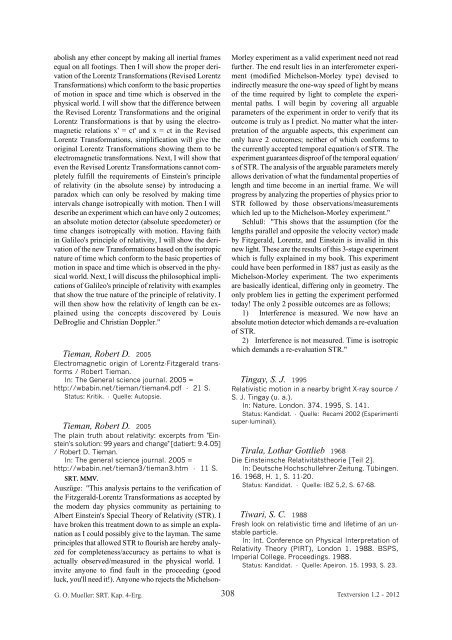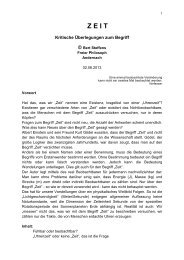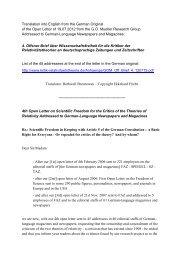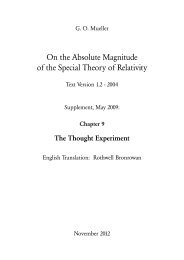2394 weitere kritische Veröffentlichungen - Kritische Stimmen zur ...
2394 weitere kritische Veröffentlichungen - Kritische Stimmen zur ...
2394 weitere kritische Veröffentlichungen - Kritische Stimmen zur ...
Sie wollen auch ein ePaper? Erhöhen Sie die Reichweite Ihrer Titel.
YUMPU macht aus Druck-PDFs automatisch weboptimierte ePaper, die Google liebt.
abolish any ether concept by making all inertial frames<br />
equal on all footings. Then I will show the proper derivation<br />
of the Lorentz Transformations (Revised Lorentz<br />
Transformations) which conform to the basic properties<br />
of motion in space and time which is observed in the<br />
physical world. I will show that the difference between<br />
the Revised Lorentz Transformations and the original<br />
Lorentz Transformations is that by using the electromagnetic<br />
relations x' = ct' and x = ct in the Revised<br />
Lorentz Transformations, simplification will give the<br />
original Lorentz Transformations showing them to be<br />
electromagnetic transformations. Next, I will show that<br />
even the Revised Lorentz Transformations cannot completely<br />
fulfill the requirements of Einstein's principle<br />
of relativity (in the absolute sense) by introducing a<br />
paradox which can only be resolved by making time<br />
intervals change isotropically with motion. Then I will<br />
describe an experiment which can have only 2 outcomes;<br />
an absolute motion detector (absolute speedometer) or<br />
time changes isotropically with motion. Having faith<br />
in Galileo's principle of relativity, I will show the derivation<br />
of the new Transformations based on the isotropic<br />
nature of time which conform to the basic properties of<br />
motion in space and time which is observed in the physical<br />
world. Next, I will discuss the philosophical implications<br />
of Galileo's principle of relativity with examples<br />
that show the true nature of the principle of relativity. I<br />
will then show how the relativity of length can be explained<br />
using the concepts discovered by Louis<br />
DeBroglie and Christian Doppler."<br />
Tieman, Robert D. 2005<br />
Electromagnetic origin of Lorentz-Fitzgerald transforms<br />
/ Robert Tieman.<br />
In: The General science journal. 2005 =<br />
http://wbabin.net/tieman/tieman4.pdf - 21 S.<br />
Status: Kritik. - Quelle: Autopsie.<br />
Tieman, Robert D. 2005<br />
The plain truth about relativity: excerpts from "Einstein's<br />
solution: 99 years and change" [datiert: 9.4.05]<br />
/ Robert D. Tieman.<br />
In: The general science journal. 2005 =<br />
http://wbabin.net/tieman3/tieman3.htm - 11 S.<br />
SRT. MMV.<br />
Auszüge: "This analysis pertains to the verification of<br />
the Fitzgerald-Lorentz Transformations as accepted by<br />
the modern day physics community as pertaining to<br />
Albert Einstein's Special Theory of Relativity (STR). I<br />
have broken this treatment down to as simple an explanation<br />
as I could possibly give to the layman. The same<br />
principles that allowed STR to flourish are hereby analyzed<br />
for completeness/accuracy as pertains to what is<br />
actually observed/measured in the physical world. I<br />
invite anyone to find fault in the proceeding (good<br />
luck, you'll need it!). Anyone who rejects the Michelson-<br />
G. O. Mueller: SRT. Kap. 4-Erg.<br />
308<br />
Morley experiment as a valid experiment need not read<br />
further. The end result lies in an interferometer experiment<br />
(modified Michelson-Morley type) devised to<br />
indirectly measure the one-way speed of light by means<br />
of the time required by light to complete the experimental<br />
paths. I will begin by covering all arguable<br />
parameters of the experiment in order to verify that its<br />
outcome is truly as I predict. No matter what the interpretation<br />
of the arguable aspects, this experiment can<br />
only have 2 outcomes; neither of which conforms to<br />
the currently accepted temporal equation/s of STR. The<br />
experiment guarantees disproof of the temporal equation/<br />
s of STR. The analysis of the arguable parameters merely<br />
allows derivation of what the fundamental properties of<br />
length and time become in an inertial frame. We will<br />
progress by analyzing the properties of physics prior to<br />
STR followed by those observations/measurements<br />
which led up to the Michelson-Morley experiment."<br />
Schluß: "This shows that the assumption (for the<br />
lengths parallel and opposite the velocity vector) made<br />
by Fitzgerald, Lorentz, and Einstein is invalid in this<br />
new light. These are the results of this 3-stage experiment<br />
which is fully explained in my book. This experiment<br />
could have been performed in 1887 just as easily as the<br />
Michelson-Morley experiment. The two experiments<br />
are basically identical, differing only in geometry. The<br />
only problem lies in getting the experiment performed<br />
today! The only 2 possible outcomes are as follows;<br />
1) Interference is measured. We now have an<br />
absolute motion detector which demands a re-evaluation<br />
of STR.<br />
2) Interference is not measured. Time is isotropic<br />
which demands a re-evaluation STR."<br />
Tingay, S. J. 1995<br />
Relativistic motion in a nearby bright X-ray source /<br />
S. J. Tingay (u. a.).<br />
In: Nature. London. 374. 1995, S. 141.<br />
Status: Kandidat. - Quelle: Recami 2002 (Esperimenti<br />
super-luminali).<br />
Tirala, Lothar Gottlieb 1968<br />
Die Einsteinsche Relativitätstheorie [Teil 2].<br />
In: Deutsche Hochschullehrer-Zeitung. Tübingen.<br />
16. 1968, H. 1, S. 11-20.<br />
Status: Kandidat. - Quelle: IBZ 5,2, S. 67-68.<br />
Tiwari, S. C. 1988<br />
Fresh look on relativistic time and lifetime of an unstable<br />
particle.<br />
In: Int. Conference on Physical Interpretation of<br />
Relativity Theory (PIRT), London 1. 1988. BSPS,<br />
Imperial College. Proceedings. 1988.<br />
Status: Kandidat. - Quelle: Apeiron. 15. 1993, S. 23.<br />
Textversion 1.2 - 2012





